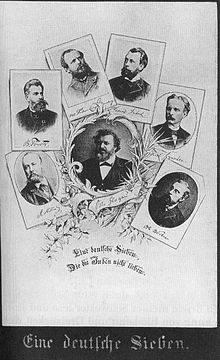Bernhard Förster
This article needs additional citations for verification. (October 2013) |
Bernhard Förster | |
|---|---|
 Bernhard Förster | |
| Born | 31 March 1843 |
| Died | 3 June 1889 (aged 46) |
| Cause of death | Suicide |
| Known for | Nueva Germania |
| Spouse(s) | Elisabeth Förster-Nietzsche |
Bernhard Förster (31 March 1843 – 3 June 1889) was a German teacher. He was married to Elisabeth Förster-Nietzsche, the sister of the philosopher Friedrich Nietzsche.

Biography[]
Förster became a leading figure in the anti-Semitic faction on the far right of German politics and wrote on the Jewish question, characterizing Jews as constituting a "parasite on the German body".[1] In order to support his beliefs he set up the Deutscher Volksverein (German People's League) in 1881 with Max Liebermann von Sonnenberg.[2]
in 1883 Förster left Germany in to emigrate to Paraguay. His anti-Semitic belief system had resulted in social ostracization and the loss of his teaching job. [3] After searching the country for many months, found a suitable site to establish a settlement. It was 600 square kilometres and almost 300 kilometres north of Asuncion. The settlement was to become known as "Nueva Germania". Forster returned to Germany in March 1885 and married Elisabeth Nietzsche on 22 May. The couple assembled a group of 'pioneers' who shared their anti-Semitic views and wished to live in a new 'Fatherland' where an Aryan could prosper. They travelled to Paraguay from Hamburg in February 1886. The initiative was a failure for many reasons, not least the harsh environment. Forster, with unserviceable debts, drank heavily and became depressed. [4] He eventually committed suicide by poisoning himself with a combination of morphine and strychnine in his room at the Hotel del Lago in San Bernardino, Paraguay on 3 June 1889.
Bernhard Förster was buried in San Bernardino.[5] After his death, his widow Elisabeth wrote a book entitled Bernhard Förster's Colony New Germany in Paraguay. Intended to salvage Förster's reputation by portraying him as a hero, the book first appeared in print in 1891.
References[]
- ^ Hannu Salmi (1994). "Die Sucht nach dem germanischen Ideal" (in German). Also published in Zeitschrift für Geschichtswissenschaft 6/1994, pp. 485-496
- ^ Karl Dietrich Bracher, The German Dictatorship, 1970, pp. 59-60
- ^ Felicori, Bianca (7 October 2019). "Nueva Germania Community". Elle Décor. Archived from the original on 30 November 2020. Retrieved 22 November 2020.
- ^ Forgotten Fatherland by Ben MacIntyre ISBN 978-1-4088-3815-0
- ^ Kracht, C., & Woodard, D., Five Years (Hanover: Wehrhahn Verlag, 2011).
- 1843 births
- 1889 deaths
- German emigrants to Paraguay
- German nationalists
- German schoolteachers
- People from Delitzsch
- People from the Province of Saxony
- Suicides by poison
- Far-right politics in Germany
- Antisemitism in Germany
- 1880s suicides